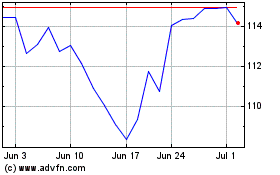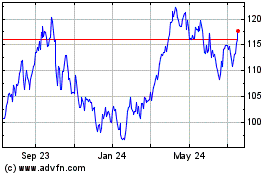By Bradley Olson and Sarah Kent
The world's biggest oil companies are awash in cash, thanks to
rising crude prices. But few, if any, are going on spending sprees,
even as the prospect of a global oil shortage looms.
Western energy giants including Exxon Mobil Corp., Chevron Corp.
and Royal Dutch Shell PLC just posted their best first-quarter
profits in years, with most besting a time when crude sold for more
than $100 a barrel.
Combined, profits at Exxon, Chevron, Shell and Total were $16.8
billion, the highest since 2014.
Yet despite a 50% surge in prices since last year, drilling
budgets at the largest oil-and-gas companies are up only about 7%,
according to consultancy Wood Mackenzie.
Large publicly traded oil companies are moving carefully because
they are under pressure from investors after spending heavily over
the past decade, when prices were higher, only to generate
underwhelming returns.
"The newfound religion and confidence in the sector is, to say
the least, fragile," said Shell Chief Executive Ben van Beurden.
"We'll need to show a little longer that we actually mean what we
say in terms of capital discipline."
By contrast, smaller U.S. shale producers -- especially those
backed by private equity -- have seized on the opportunity to ramp
up drilling and gain market share.
Two years ago, the top 30 U.S. companies accounted for almost
64% of production in the contiguous U.S. That percentage has fallen
to 60% this year, according to consultancy Rystad Energy.
"Big companies are still cutting coupons to show that they can
live within their means," said Adam Flikerski, managing partner at
BlackGold Capital Management LP, an asset manager that specializes
in oil and gas lending. "Like technology companies, the smaller
players are still rewarded for growth."
The wary response from the world's biggest producers comes as a
global oil glut that has hung over the industry for the past four
years finally appears to be withering away. Without stepped-up
spending on new oil production, the International Energy Agency
warns, the world could flip from abundance to supply crunch by
2020.
Still, many investors in publicly traded oil and gas producers
are pressing executives not to sow the seeds of another price crash
with excessive growth. Their apathy about oil's rally has
shown.
While the price of Brent crude, the international oil benchmark,
is up around 11% this year, a leading barometer of energy stocks,
the MSCI World Energy Index, is only up around 4%. A number of
companies have performed even worse. Exxon is down 3.9%.
The pace of share buybacks has been a key factor for performance
so far. ConocoPhillips shares rose 3% Thursday after the company
disclosed it had repurchased about $500 million in stock, as it
reported that quarterly profits jumped 52% to $888 million.
Exxon fell 3.4% Friday after announcing that it hasn't yet
reinstated its longstanding program for buying back shares.
Exxon's net income rose 16% to $4.7 billion, but production fell
6% to below 4 million barrels a day after an earthquake in Papua
New Guinea knocked out natural gas production in the country.
Revenue rose 16% to $68 billion.
Although the company posted its highest cash flow since 2014, it
still fell short of analyst expectations for the second straight
quarter and shares fell 3.4% Friday.
Chevron's profit rose 36% to $3.6 billion, while output rose
6.5% to the equivalent of about 2.9 million barrels a day. Its
shares rose 1.8% Friday after it reported revenue surged 13% to
about $38 billion.
Executives at Exxon and Chevron said they continue to weigh
whether to reinstate share buybacks, a longstanding practice they
discontinued after the 2014 price collapse, but said paying
dividends and reinvesting in attractive prospects are higher
priorities.
"Buybacks remain on the table," said Jeff Woodbury, Exxon's vice
president of investor relations. "We are intensely focused on
value."
Shell's U.K. shares fell 0.7% on Thursday after the company
missed cash flow expectations and failed to give more clarity on
when it would begin buying back $25 billion in stock, as it
reported quarterly profits rose by two-thirds to nearly $6
billion.
One reason for caution among larger companies is that some
analysts, investors and executives still lack faith that crude
prices will remain elevated through the end of the year.
"There's potential weakness on the horizon in oil prices," said
Tom Ellacott, senior vice president for corporate research at Wood
Mackenzie. "It's still quite an uncertain environment."
Smaller U.S. producers are exercising less caution, as many of
them still have business models akin to startups. They must invest
in new wells to prove the viability of new prospects.
Those companies are a major reason why forecasters say U.S. oil
output may reach 11 million barrels a day by the end of the year,
surpassing the output of Saudi Arabia.
In February, companies that aren't among the top U.S. crude
producers made up almost half the permits approved for new
drilling, according to data and analytics firm DrillingInfo. In the
past six months, those operators accounted for about 42% of
permits. Permits are generally a useful barometer for future
drilling activity.
Many such companies will be affected by shortages in labor and
trucking, as well as pipeline bottlenecks in the Permian basin in
West Texas and New Mexico, the heart of U.S. drilling activity.
Those challenges could curtail production by about 400,000 barrels
a day, but output will continue surging as many companies have
secured the supplies and contracts needed to meet their goals, said
Artem Abramov, vice president of analysis at Rystad.
"We've got a completely new generation of small, private players
with very ambitious growth plans in the Permian basin," he said.
"Those plans will continue."
Write to Bradley Olson at Bradley.Olson@wsj.com and Sarah Kent
at sarah.kent@wsj.com
(END) Dow Jones Newswires
April 27, 2018 14:29 ET (18:29 GMT)
Copyright (c) 2018 Dow Jones & Company, Inc.
Exxon Mobil (NYSE:XOM)
Historical Stock Chart
From Mar 2024 to Apr 2024

Exxon Mobil (NYSE:XOM)
Historical Stock Chart
From Apr 2023 to Apr 2024
